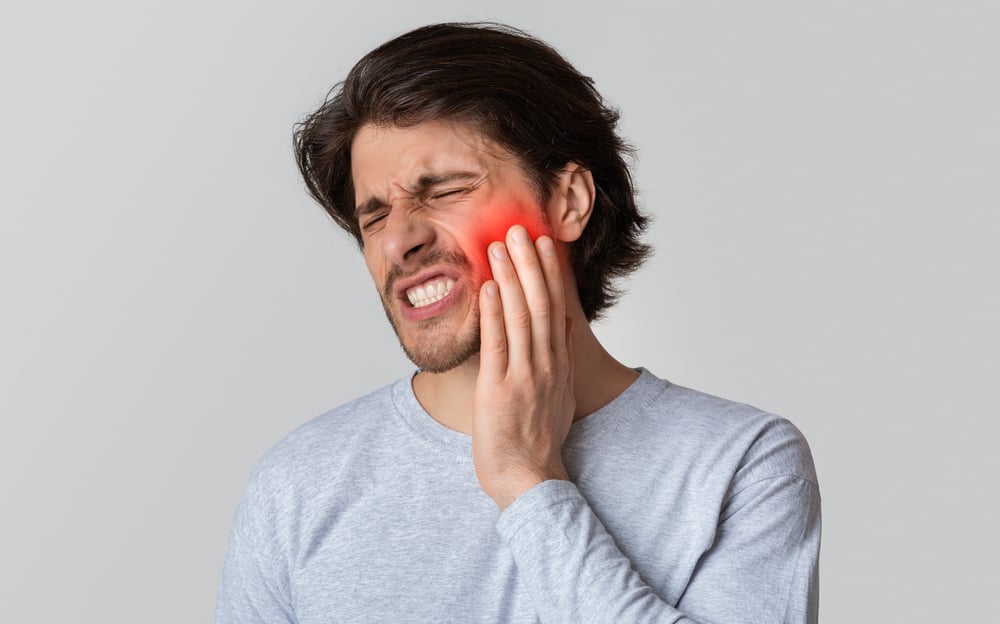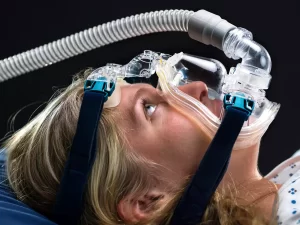Are you considering using a CPAP machine to help with your sleep apnea? If so, you may be wondering if there is any risk of developing dry socket, if you use your CPAP after a tooth extraction.
Dry socket is an extremely painful condition in which the bone and nerves around the wound site become exposed after extraction of a tooth. In this article, we’ll explore the potential risks associated with using a CPAP machine and whether it could cause dry socket.
CPAP machines are a popular treatment for those suffering from sleep apnea, a disorder that causes one to stop breathing during sleep.
The device uses pressurized air to keep the airway open while sleeping and helps prevent episodes of apnea. While CPAP machines can provide much-needed relief for those who suffer from sleep apnea, could they potentially lead to other complications such as dry socket?
In this article, we’ll take a closer look at the possible link between CPAP use and dry socket. We’ll discuss what causes dry socket and how to safely use CPAP after tooth extraction.
Definition Of CPAP
CPAP stands for Continuous Positive Airway Pressure. It’s a machine that uses air pressure to keep your airways open while you sleep, making it easier to breathe. CPAP machines come with a mask or nosepiece that is worn over the nose and mouth during sleep. The air pressure is adjusted depending on your specific needs, usually determined by a doctor.
CPAP machines help those with sleep apnea get a better night’s rest by preventing pauses in breathing caused by blockage of the airway. This can reduce symptoms such as snoring, daytime sleepiness and fatigue, morning headaches, and difficulty concentrating during the day.
CPAP therapy has been linked to other health benefits, including improved cardiovascular function and reduced risk of depression.CPAP therapy also has short or long-term side effects, one of them being dry socket.
What Is Dry Socket?
Dry socket, also known as alveolar osteitis, is a painful dental condition that can occur after a tooth extraction.
It typically happens when the blood clot that forms in the socket where the tooth used to be is dislodged or dissolves before the wound has had a chance to heal.
This leaves the underlying bone and nerves exposed to air, food, fluid, and bacteria, leading to pain and sometimes infection.
Causes Of Dry Socket
- Disruption of Blood Clot: The most direct cause of dry socket is the loss or disruption of the blood clot that forms in the socket after tooth extraction. This clot is crucial for healing, as it protects the bone and nerve endings in the empty tooth socket.
- Smoking and Tobacco Use: Smoking or using tobacco products significantly increases the risk of dry socket. Tobacco can impede healing and may contaminate the wound site. The act of smoking can also physically dislodge the blood clot.
- Oral Hygiene and Infection: Poor oral hygiene can increase the risk of dry socket. Bacteria in the mouth can prevent proper clot formation or lead to the breakdown of the clot. Pre-existing infections around the extracted tooth can contribute to the development of dry socket.
- Traumatic Extraction: If the tooth extraction is difficult or traumatic, it can increase the risk of dry socket. This includes greater manipulation of the tooth or surrounding tissues, which can disrupt normal healing.
- Use of Birth Control Pills: High estrogen levels from oral contraceptives can disrupt the normal healing process and increase the risk of dry socket.
- Rinsing and Spitting: Vigorous rinsing and spitting within the first 24 hours after extraction can dislodge the blood clot.
- Drinking Through a Straw: The suction motion from drinking through a straw can dislodge the blood clot.
- CPAP Machine Use: if you haven’t healed properly, using your CPAP machine after a tooth extraction can lead to a dry socket.
- Physical Activity: Engaging in physical activity too soon after surgery can increase pressure on the extraction and dislodge the clot.
Symptoms Of Dry Socket
The symptoms usually develop a few days after the extraction and can be quite severe. Here are the key symptoms associated with dry socket:
- Severe Pain: One of the most noticeable symptoms of dry socket is intense pain at the site of the extraction. This pain typically develops within one to three days after the tooth is removed. It can be a sharp, throbbing, or aching pain.
- Pain Radiating to the Ear, Eye, Temple, or Neck: The pain from the socket can often radiate to other areas of the same side of your face, such as the ear, eye, temple, or neck.
- Visible Bone in the Socket: In cases of dry socket, the protective blood clot is missing, and you might be able to see the bone within the socket.
- Partial or Total Loss of the Blood Clot: The socket where the tooth was extracted either has a partial or total loss of the blood clot, which is essential for healing.
- Bad Breath or Foul Taste: Due to the exposed tissue and possible bacterial growth within the socket, you might experience bad breath or a foul taste in your mouth.
- Swollen Lymph Nodes Around the Jaw or Neck: Sometimes, the lymph nodes around your jaw or neck may become swollen and tender due to the infection.
- Slight Fever: In some cases, dry socket can be accompanied by a slight fever as your body reacts to the infection.
If you experience any of these symptoms after a tooth extraction, speak to your dentist or oral surgeon promptly. Early treatment can help alleviate pain and promote proper healing. Treatment typically involves cleaning the socket, applying a medicated dressing, and managing pain.
Do not use your CPAP machine, if you developed dry socket, until you get cleared by your dentist or oral surgeon.
Diagnosis Of Dry Socket
Diagnosing dry socket typically involves a physical examination by your dentist, along with considering your symptoms and medical history. X-rays are usually not necessary for diagnosis but may be taken to rule out other causes of your pain.
Here’s what the dentist will look for during the examination:
- Appearance of the extraction site: In dry socket, the blood clot is either dislodged or never formed properly, exposing the underlying bone. This will appear as a hollow socket with visible bone.
- Pain: Dry socket pain is typically severe and throbbing, often described as radiating to the ear, eye, temple, or neck on the same side as the extraction. It usually starts 2-3 days after the extraction and worsens instead of improving.
- Other symptoms: Bad breath, an unpleasant taste in your mouth, and slight fever might also be present.
Note that not everyone who experiences pain after a tooth extraction has dry socket. Other conditions, such as an infection or nerve damage, can also cause similar symptoms.
See your dentist for a proper diagnosis and treatment if you’re experiencing any concerning symptoms after a tooth extraction.
How Does CPAP Affect Oral Health?
Continuous positive airway pressure (CPAP) therapy is the first-line treatment for obstructive sleep apnea (OSA), a condition where your breathing repeatedly stops and starts during sleep.
While CPAP is highly effective in improving sleep quality and overall health, it can also have some impact on oral health.
Here are some of the ways CPAP can affect oral health:
- Dry mouth: CPAP delivers pressurized air through a mask worn over the nose or mouth. This airflow can lead to dry mouth, especially if you breathe through your mouth during sleep. Dry mouth can increase the risk of cavities, gum disease, and mouth sores.
- Bruxism (teeth grinding): The pressure from the CPAP mask and the noise of the machine can sometimes trigger bruxism, or teeth grinding. This can wear down your teeth and lead to pain and sensitivity.
- Changes in jaw alignment: In some cases, long-term use of CPAP therapy may lead to slight changes in the alignment of your jaw. This is usually not a major concern, but it’s important to see your dentist regularly for checkups.
Can CPAP Cause Dry Socket?
CPAP itself does not directly cause dry socket (alveolar osteitis), which is a condition that occurs when the blood clot at the site of a tooth extraction is dislodged or dissolves before the wound has healed. However, the use of CPAP after a tooth extraction could potentially increase the risk of developing dry socket in the following ways:
- Air Pressure: The air pressure from the CPAP machine, especially if it’s set too high, might potentially dislodge the blood clot that forms in the socket after a tooth extraction. This is more of a concern if the mask does not fit properly or if it directs air flow towards the extraction site.
- Mouth Dryness: CPAP can sometimes cause dryness in the mouth, which might affect the healing process after a tooth extraction.
- Mask Fit and Movement: If the CPAP mask fits tightly around the jaw or puts pressure on the extraction site, it could potentially disrupt the clot.
It’s important to note that these are potential risks and not definitive outcomes. Many people use CPAP machines and undergo dental procedures without any complications.
Risk Factors For Developing Dry Socket With CPAP Use
Using a CPAP machine after a tooth extraction can potentially increase the risk of developing dry socket, although this is not a common complication.
Dry socket, or alveolar osteitis, occurs when the blood clot at the site of a tooth extraction is dislodged or dissolves before the wound has healed, exposing the underlying bone and nerves.
Here are some risk factors to consider when using CPAP after tooth extraction:
- High Air Pressure Settings: CPAP machines that are set to a high air pressure might increase the risk of dislodging the blood clot at the extraction site, especially if the air flow is directed towards the mouth.
- Improper Mask Fit: A CPAP mask that does not fit properly can direct air flow towards the extraction site or create pressure points that might disturb the blood clot.
- Mouth Breathing: If the CPAP user predominantly breathes through the mouth, this might increase the risk of dry socket due to air flow directly impacting the extraction site.
- Recent Tooth Extraction: The risk of dry socket is generally highest in the first few days following a tooth extraction. Using CPAP during this critical healing period might increase the risk, especially if other risk factors are present.
- Type of Tooth Extracted: The location of the extracted tooth might also play a role. Extractions involving molars, particularly wisdom teeth, are more commonly associated with dry socket.
- Personal Risk Factors: Individuals who have other risk factors for dry socket, such as smoking, poor oral hygiene, or a history of dry socket, might have an increased risk when using CPAP after an extraction.
- Lack of Humidification: CPAP machines without adequate humidification can cause dryness in the mouth, which might affect the healing process.
Ways To Reduce Risk Of Developing Dry Socket With CPAP Use
Talk to your doctor about your CPAP use with your dentist or oral surgeon before and after the extraction. They might recommend temporary adjustments to your CPAP therapy. Consider using a CPAP machine with a humidifier to reduce mouth dryness.
Ensure your CPAP mask fits properly and is adjusted to minimize direct air flow towards the extraction site.
Follow all post-extraction care instructions provided by your dentist or oral surgeon to promote healing.
Treatment Options For Dry Socket After CPAP Use
Treatment for dry socket typically involves a combination of professional dental care and home care strategies. Here are the common treatment options post extraction, if you have developed dry socket:
Professional Dental Treatment
- Socket Cleaning: The dentist or oral surgeon will gently clean the socket to remove any debris or food particles that could be causing infection or irritation.
- Medicated Dressings: A medicated dressing or packing is often placed in the socket to protect it and reduce pain. These dressings may need to be replaced every few days.
- Pain Medications: Pain relief is a crucial aspect of treating dry socket. Your dentist may recommend over-the-counter pain relievers like ibuprofen or acetaminophen, or in some cases, prescribe stronger medication.
- Antibiotics: If there is an infection or a high risk of infection, antibiotics may be prescribed.
Home Care
- Oral Hygiene: Maintain good oral hygiene by gently rinsing your mouth with warm salt water or an antiseptic mouth rinse as recommended by your dentist. Avoid vigorous rinsing to prevent further disruption of the area.
- Avoid Smoking and Tobacco: Smoking can delay healing and should be avoided.
- Soft Diet: Eat soft foods that don’t require much chewing and avoid foods that might get lodged in the socket.
- Rest and Avoid Strenuous Activity: Resting and avoiding strenuous activities can help the healing process.
Adjustments to CPAP Use
- Consult with Your Sleep Specialist: Discuss your dry socket condition with your sleep specialist. They might suggest temporary adjustments to your CPAP therapy, such as reducing the air pressure or changing the mask type.
- Humidification: Using a humidifier with your CPAP machine can help keep your mouth and throat moist, which is beneficial for healing.
- Proper Mask Fit: Ensure your CPAP mask fits properly to minimize direct air flow towards the extraction site.
Regular follow-up post-operative appointments with your dentist or oral surgeon are important to monitor the healing process and make any necessary adjustments to the treatment plan.
Preventing dry socket after a tooth extraction involves taking steps to protect the blood clot that forms in the socket, which is crucial for proper healing. Here are key measures to help prevent dry socket:
- Follow Post-Extraction Instructions: Adhere strictly to the aftercare instructions provided by your dentist or oral surgeon. This typically includes guidance on how to care for your mouth immediately after the procedure.
- Avoid Smoking and Tobacco: Smoking or using tobacco products can impede healing and increase the risk of dry socket. It’s advisable to avoid smoking for at least 48 hours after extraction, and ideally longer.
- Avoid Sucking Motions: Activities like drinking through a straw, spitting vigorously, or sucking on candies can dislodge the blood clot. Avoid these actions for at least a few days post-extraction.
- Soft Diet: Stick to a soft diet for the first few days. Avoid hard, crunchy, spicy, or sticky foods that might disturb the clot or get lodged in the socket.
- Gentle Oral Hygiene: Keep your mouth clean to prevent infection. Brush your teeth gently, avoiding the extraction site. Your dentist may recommend rinsing with warm salt water or a prescribed mouthwash to help keep the area clean.
- Limit Physical Activity: Avoid strenuous physical activity for a few days after the extraction as it can increase blood pressure and potentially dislodge the blood clot.
- Proper Rest: Get plenty of rest and keep your head elevated with pillows to reduce bleeding and swelling.
- Stay Hydrated: Drink plenty of water to stay hydrated, but remember to avoid using straws.
- Pain Management: If you experience pain, use the pain relief methods recommended by your dentist, such as over-the-counter pain relievers. Avoid aspirin as it can increase bleeding.
- Attend Follow-Up Appointments: Go to any scheduled follow-up appointments with your dentist or oral surgeon to ensure proper healing.
- Immediate Action on Symptoms: If you notice any signs of dry socket or experience severe pain, contact your dentist or oral surgeon immediately.
By following these preventive measures, you can significantly reduce the risk of developing dry socket after a tooth extraction.
FAQ
Does CPAP Therapy Increase Your Chance of Dry Socket
CPAP does not directly cause dry socket, but it may potentially increase the risk of developing this condition after a tooth extraction. Dry socket, or alveolar osteitis, occurs when the blood clot at an extraction site is dislodged, exposing the underlying bone and nerves.





[…] Dry socket: Dry socket is a painful condition that can occur after a tooth extraction. It happens when the blood clot that forms at the extraction site is dislodged. The suction from the CPAP mask can dislodge the blood clot and increase the risk of dry socket. (READ MORE: Will CPAP Cause Dry Socket?) […]